Northrop’s OmegA Rocket Set for May Test Fire

OmegA Rocket. Photo by Northrop Grumman.
Northrop Grumman is moving ahead on schedule to field its new OmegA rocket by 2021 in hopes that the U.S. Air Force will select it as one replacement to the Russian-made RD-180, with the first stage test firing scheduled for May 31, one official said April 8.
“Our RD-180 replacement is going to be fired in May and should be ready to fly after that,” said Kent Rominger, vice president of strategic programs for the company’s propulsion systems division, at a media roundtable at the Space Foundation’s 35th annual Space Symposium.
A second stage test firing is scheduled for August, with both tests taking place at Northrop Grumman’s Promontory, Utah test site, he added. Northrop Grumman acquired Orbital ATK in 2018 to form Northrop Grumman Innovation Systems.
OmegA is one of three space launch vehicles being developed under the Air Force’s launch services procurement effort, and Northrop Grumman is competing with Blue Origin, United Launch Alliance (ULA) and Space X for the chance to split up to 25 national security launches between two providers over a five-year period as part of the National Security Space Launch (NSSL) program (Defense Daily, Oct. 10, 2018).
Rominger said he is confident that Northrop Grumman will be able to field the OmegA medium variant rocket by 2022 – when the Air Force plans to cease use of the RD-180 rockets – and the heavy variant by 2025. Two flight certification tests for the medium-lift rocket are scheduled in 2021 and two heavy-lift certification tests are scheduled in 2024.
Northrop Grumman has selected Aerojet Rocketdyne’s RL10 engine to power the upper stage of OmegA, he noted.
Amid alleged complaints from other vendors and concerns from members of Congress that the Air Force is moving too fast to release the request for proposals for the second phase of the launch services procurement program, Rominger said he wanted the program to move faster, not slower.
“From Day One, we designed this system to meet the schedule. I honestly believe we’re going to show up on time, so I’m a proponent of it not slipping,” he said. “As a taxpayer, we have some pretty serious, important payloads to get on orbit, and the deadline at the end of December 2022 is rapidly approaching.”
Lawmakers have also questioned the Air Force’s plan to downselect from four competitors to two in phase 2, while the service insists that there is not enough prospective business for three vendors in the current NSSL program (Defense Daily, March 29).
Rominger said he agreed with the Air Force that “two is the right answer” even though his company would face better odds of a contract should three out of four vendors be selected.
While Northrop Grumman is building OmegA with potential commercial and civil customers in mind along with the Air Force, the commercial market can be unpredictable, he noted.
“I think the Air Force feels pretty good about having five missions a year,” he added. “If they give it to two, one gets three per year, the other gets two. Our business case closes on two launches per year, and we plan on picking up some commercial, some NASA, but always having the two lets us ebb and flow.”
Northrop Grumman presents a persuasive business case to the Air Force due to its existing manufacturing infrastructure and workforce, Rominger said. The company runs the two largest solid rocket motor facilities worldwide and is using “a fraction” of its potential space, he noted.
“We’re robust enough, we could go down to very few launches per year” if necessary without disrupting its production line, he said.
Should Northrop Grumman continue through the program, it could receive up to $792 million from the Air Force to develop the vehicle, build out its launch sites and fund certification flights. On top of that funding, the company is providing over one-third of that sum in its own money toward the program, Rominger said.
Read more of Vivienne’s Space Symposium Coverage at Defense Daily